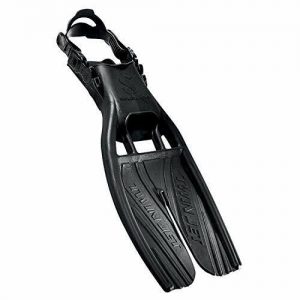Introduction
Quick Navigation
Scuba-diving, like most water sports, is an extensive and exciting activity with its own equipments and instruments with which it’s carried out. These equipment which are quite essential and basic for scuba-diving, include wetsuits, diving gear, scuba find, drysuits, among others. Scuba-diving occurs in water bodies of great depths and sometimes may be regarded as dangerous, especially for amateurs.
Read about scuba weights‘ here.
One essential feature of every diver’s gear is a scuba fin. When compared to other fins, scuba fins are bulkier, stiffer, and longer. The length of this fin and its bulky weight enables the diver to move in water effectively. Scuba fins are manufactured in a way that they might be inefficient in other diving sports like snorkeling. Like most fins, scuba fins are made of plastic or rubber. Some are also made of a combination of materials which are usually quality polyurethane.
Scuba fins are divided into the blade section and foot pocket section or shoe. The shoe of the fin, as the name implies, is where the diver’s feet are placed while the blade acts as a propeller moving the diver through water. Some blades have vents and ridges, which help to improve performance and provide balance. Some shoes are enclosed all through while others are open. The modern creation and design of the fin is attributed to Louis de Corlieu, a Lieutenant Commander of the French Navy who created the scuba fin from the inspiration he received while watching the webbed feet of ducks and frogs.
Types Of Scuba Fins
The different classes of fins are used for several reasons. However, these different types can be categorized into two; fins according to the shoe part and fins according to the blade used and design. In accordance with the shoe part, we have two types of scuba fins; the open-heeled fins and the closed-heeled fins, also called full foot fins.
See differences between dive fins and snorkel fins‘ here.
Open-heeled fins
Open-heeled fins are the most used scuba-diving fins favored by a majority of scuba-divers around the globe. They are usually shaped in the form of slippers offering space enough for heat providing neoprene shoes, also called booties to be used with it. The feet of the drysuits can also be worn underneath them. They are usually used in cold water due to the heat provided by the booties, but they can also be used in warm waters.
They have relatively large foot pockets and shoes, considering that they were created to accommodate neoprene shoes. They are indeed ideal for beach entry diving which involves the diver walking a distance on stairs or sand before the dive. Straps of open-heeled fins can be quite weak and tend to break while in use, and the open-heeled fins also can be expensive and bulky.
Closed-heeled fins
Close heeled fins are popularly used despite the presence of modern designs of fins. They are very affordable and less expensive in contrast to the open-heeled fins. They have small shoes because they do not require the use of booties to go with them. They are best suited for warm water diving as they offer no protection from cold of any kind. Closed heeled fins are not adjustable and, as such, can cause injuries to the skin of the diver. They are also called full foot fins as they cover the feet wholly and are usually work barefooted. They are less bulky, too, and usually fit the foot well. Due to the relatively lightweight of the closed heel fins, they are arguably the best when buoyancy is intended to be achieved. Closed heels fins are best for tropical waters and boat entries.
According to the blade used and fin design, we have the following types:
Paddle fins
Paddle fins are the most common and basic of all scuba fins. They function with similarities to the oars of a ship’s work and how they wade through water. They often function as an extension of the foot while kicking, providing ample surface area for the diver to propel himself. They come in several variations to improve efficiency. Most paddle fins have stabilizing rods on the side of the fin that helps to push the diver by channeling the water behind the diver. As a result of the nature of the fin, it is perfect for beginners and is highly versatile. They have a very simple design and a flat base surface.
Split fins
These scuba-diving fins have a slit below in the center of the fin. The slit may vary in width but are usually often narrow. They are commonly regarded as the most efficient fins for divers and function like the propeller on a boat or airplane. The water is not pushed behind the diver with the case of the paddle fin, but the diver is propelled by a lift as water passes through the slit.
Hinged fins
They are relatively new designs of scuba fins. They have a point in the blade that hinges and improves performance by allowing the blade to move to a very suitable angle.
Vented fins
They are also new to the scuba fin technology. They are fins with vents situated at the base of the foot pocket. They allow water to pass through the fins, in a way reducing efforts and increasing efficiency of kick. They are also designed to increase propulsion as water streams over the length of the blade.
Force fins
They are new designs that are cut in a v- shape at the end of the blade and mostly resemble a fishes’ tail. They are usually made of polyurethane and also very light. They are quite efficient and give the diver a very high-speed acceleration.
Conclusion
These different types of scuba fins are efficient and highly useful in different climes and dive sites. Fins which are essential parts of a diver’s gear, should be cared for properly to ensure durability. Blades and straps of the fins should be kept clean, and scuba fins should always be stored flat in order to avoid a permanent bend that can disrupt in-water performance.
See the different fishing rods‘.

